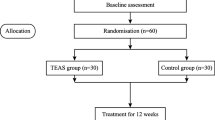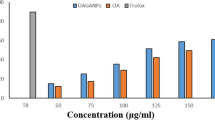Abstract
Objectives
To investigate the effect on essential hypertension of the topical application of TAT-Cu, Zn-superoxide dismutase (TAT-SOD) at left acupoint Zusanli (ST 36), and to observe whether the change of electrical potential difference (EPD) can be related to the change of blood pressure.
Methods
Sixteen patients with essential hypertension and 16 healthy subjects were included in the study. EPD between the left acupoints of Yanglingquan (GB 34) and Qiuxu (GB 40) was firstly screened out for the EPD detection. An intracellular superoxide quenching enzyme, TAT-SOD, was topically applied to the acupoint ST 36 within an area of 1 cm2 once a day, and the influence on EPD was investigated. The dosage applied to TAT-SOD group (n=8) was 0.2 mL of 3000 U/mL TAT-SOD cream prepared by adding purified TAT-SOD to a vehicle cream, while placebo group (n=8) used the vehicle cream instead. The left acupoints of Yanglingquan (GB 34) and Qiuxu (GB 40) were selected for EPD measurement after comparing EPD readings between 5 acupoints on each of all 12 meridians.
Results
EPDs between the left acupoints of GB 34 and GB 40 for 16 patients of essential hypertension and 16 healthy subjects were 44.9±6.4 and 5.6±0.9 mV, respectively. Daily application of TAT-SOD for 15 days at ST 36 of essential hypertension patients significantly decreased systolic blood pressure (SBP) and diastolic blood pressure (DBP) of 179.6 and 81.5 mm Hg to 153.1 and 74.1 mm Hg, respectively. Responding to the change in blood pressure, EPD between the left acupoints of GB 34 and GB 40 also declined from 44.4 to 22.8 mV with the same trend. No change was observed with SBP, DBP and EPD between the left acupoints of GB 34 and GB 40 with the daily application of the placebo cream.
Conclusion
Enzymatic scavenging of the intracellular superoxide at ST 36 proved to be effective in decreasing SBP and DBP. The results reconfirm the involvement of superoxide anions and its transportation along the meridians, and demonstrate that EPD between acupoints may be an indicator to reflect its functioning status. Moreover, preliminary results suggest a close correlation between EPD and blood pressure readings, implying a possibility of using EPD as a sensitive parameter for blood pressure and to monitor the effect of antihypertensive treatment.
Similar content being viewed by others
References
Rong P, Zhu B, Li Y, Gao X, Ben H, Li Y, et al. Mechanism of acupuncture regulating visceral sensation and mobility. Front Med 2011;5:151–156.
Voll R. Twenty years of electro-acupuncture diagnosis in Germany. A progress report. Am J Acupunct 1975;3:7–17.
Nakatani Y. An aspect of the study of Ryodoraku. Clin Chin Med (Chin) 1956;3:54.
Ahn AC, Martinsen OG. Electrical characterization of acupuncture points: technical issues and challenges. J Alternat Complement Med 2007;13:817–824.
Ahn AC, Park M, Shaw JR, McManus CA, Kaptchuk TJ, Langevin HM. Electrical impedance of acupuncture meridians: the relevance of subcutaneous collagenous bands. PLoS One 2010;5:e11907.
Lorenzen I, Mullen L, Bekeschus S, Hanschmann EM. Redox regulation of inflammatory processes is enzymatically controlled. Oxid Med Cell Longev 2017;2017:8459402.
Dolowschiak T, Chassin C, Ben Mkaddem S, Fuchs TM, Weiss S, Vandewalle A, et al. Potentiation of epithelial innate host responses by intercellular communication. PLoS Pathog 2010;6:e1001194.
Bechtel W, Bauer G. Modulation of intercellular ROS signaling of human tumor cells. Anticancer Res 2009;29:4559–4570.
Guo J, Liu S, Cheng X, Zhou J, Ke L, Chen X, et al. Revealing acupuncture meridian-like system by reactive oxygen species visualization. Biosci Hypotheses 2009;2:443–445.
Guo J, Chen Y, Yuan B, Liu S, Rao P. Effects of intracellular superoxide removal at acupoints with TAT-SOD on obesity. Free Radic Biol Med 2011;51:2185–2189.
Moore K, Roberts LJ. Effects of intracellular superoxide removal at acupoints with TAT-SOD on obesity. Free Radic Biol Med 2011;51:2163.
Guo J, Xu M, Zheng M, Liu S, Zhou J, Ke L, et al. Topical application of TAT-superoxide dismutase in acupoints LI 20 on allergic rhinitis. Evid Based Complement Alternat Med 2016;2016:3830273.
Ye N, Liu S, Lin Y, Rao P. Protective effects of intraperitoneal injection of TAT-SOD against focal cerebral ischemia/reperfusion injury in rats. Life Sci 2011;89:868–874.
Zhang C, Chen X, Liu S, Liu Y, Rao P. Protective and repairing abilities of fusion protein PTD-SOD for L-02 cell irradiated by UV-C. J Radiat Res Radiat Process 2007;25:248–251.
Pan J, Peng S, Zhou J, He H, Liu S, Rao P. Protective effects of recombinant protein PTD-SOD on guinea pigs damaged by ultraviolet B. Radiat Prot 2010;30:284–288.
Zhao H, Pan J, Liu S, Zhang C, Rao P. Membrane transduction activity of TAT-SOD fusion protein. J Fuzhou Univ 2007;35:936–940.
Zhao H, Zhang C, Liu Y, Liu S, Rao P. PTD-SOD protects cells against cell injury caused by UV-B. J Fuzhou Univ 2009;37:446–451.
Pan J, Zhou J, Peng S, He H, Liu S, Rao P. The preventing effects of recombinant protein PTD-SOD on guinea pigs damaged by Ultraviolet B. J Radiat Res Radiat Process 2009;27:297–302.
Xu M, Guo J, Xu J, Zhang C, Liu S, Liao R, et al. Monitoring the effects of acupoint antioxidant intervention by measuring electrical potential difference along the meridian. Evid Based Complement Alternat Med 2015;2015:286989.
Xu M, Guo J, Ni L, Rao P, Chen H, Chen Y. Effect of infusions of tea soup on electrical potential difference along the meridian. J Chin Instit Food Sci Technol (Chin) 2018;18:27–33.
Tam KC, Yiu HH. The effect of acupuncture on essential hypertension. Am J Chin Med 1975;3:369–375.
Zhang Y, Du Y. Acupuncture combined with medication for morning blood pressure of essential hypertension. Chin Acupunct Moxibust 2018;38:343–348.
González J, Valls N, Brito R, Rodrigo R. Essential hypertension and oxidative stress: new insights. World J Cardiol 2014;6:353–366.
Wang Y, Li Y, Zhou L, Guo L. Protective effects of electroacupuncture at LR3 on cardiac hypertrophy and apoptosis in hypertensive rats. Acupunct Med 2016;34:201–208.
Severcan C, Cevik C, Acar HV, Sivri AB, Mit SS, Geçioğlu E, et al. The effects of acupuncture on the levels of blood pressure and nitric oxide in hypertensive patients. Acupunct Electrother Res 2012;37:263–275.
Chen H, Huang X, Chen C, Liu S, Rao P. Effect of shaking-flask conditions on Expression of PTD-SOD by Escherichia Coli. J Med Theor Prac (Chin) 2006;19:1255–1257.
Sung J, Han KH, Zo JH, Park HJ, Kim CH, Oh BH. Effects of red ginseng upon vascular endothelial function in patients with essential hypertension. Am J Chin Med 2000;28:205–216.
World Health Organization Regional Office for the Western Pacific. WHO standard acupuncture point locations in the Western Pacific Region. Geneva: World Health Organization; 2008.
Wang GB, Liu C, Wu LB, Yan B, Gao SZ, Shao GR, et al. Functional magnetic resonance imaging on acupuncturing Yuan-Source and He-Sea acupoints of Stomach Meridian of Foot-Yangming. Acta Acd Med Sin (Chin) 2009;31:171–176.
Yang X, Zhao H, Wang J. Chinese massage (Tuina) for the treatment of essential hypertension: a systematic review and meta-analysis. Complement Ther Med 2014;22:541–548.
Lee Y, Kim S, Son T, Kang D, Jung B. Meridian electrical potential response to acupuncture stimulation between operator and subject. J Acupunct Meridian Stud 2010;3:249–254.
Khorsand A, Zhu J, Bahrami-Taghanaki H, Baghani S, Ma L, Rezaei S. Investigation of the electrical impedance of acupuncture points and non-acupuncture points before and after acupuncture, using a four-electrode device. Acupunct Med 2015;33:230–236.
Acknowledgment
We thank XU Jin-sen of Fujian University of Traditional Chinese Medicine, who gave us great help in the clinical trial application.
Author information
Authors and Affiliations
Contributions
Guo JK, Xu JS, Chen TB, Wang Q and Rao PF designed the study, analysed the data, and prepared this manuscript; Guo JK, Xu JS, Xu MM and Zhang CX performed the research; Liu ST, Ke LJ and Zhou JW finished TAT-SOD expression; Guo JK, Xu MM and Zhang CX researched electric properties of acpoints. All authors contributed to the scientific discussion.
Corresponding author
Additional information
Conflict of Interests
The authors declare that there is no conflict of interests regarding the publication of this paper.
Supported by National Key R&D Program of China (No. 2016YFD0400202), National Natural Science Foundation of China (No. 31500685, 30973720), Zhejiang Provincial Natural Science Foundation of China (No. LY16C050002), and Start-Up Fund of Research in Quanzhou Normal University (No. G16062)
Rights and permissions
About this article
Cite this article
Guo, Jk., Xu, Js., Chen, Tb. et al. Effects of TAT-SOD at Acupoints on Essential Hypertension by Monitoring Meridians Electrical Potential. Chin. J. Integr. Med. 26, 694–700 (2020). https://doi.org/10.1007/s11655-019-3173-9
Accepted:
Published:
Issue Date:
DOI: https://doi.org/10.1007/s11655-019-3173-9




